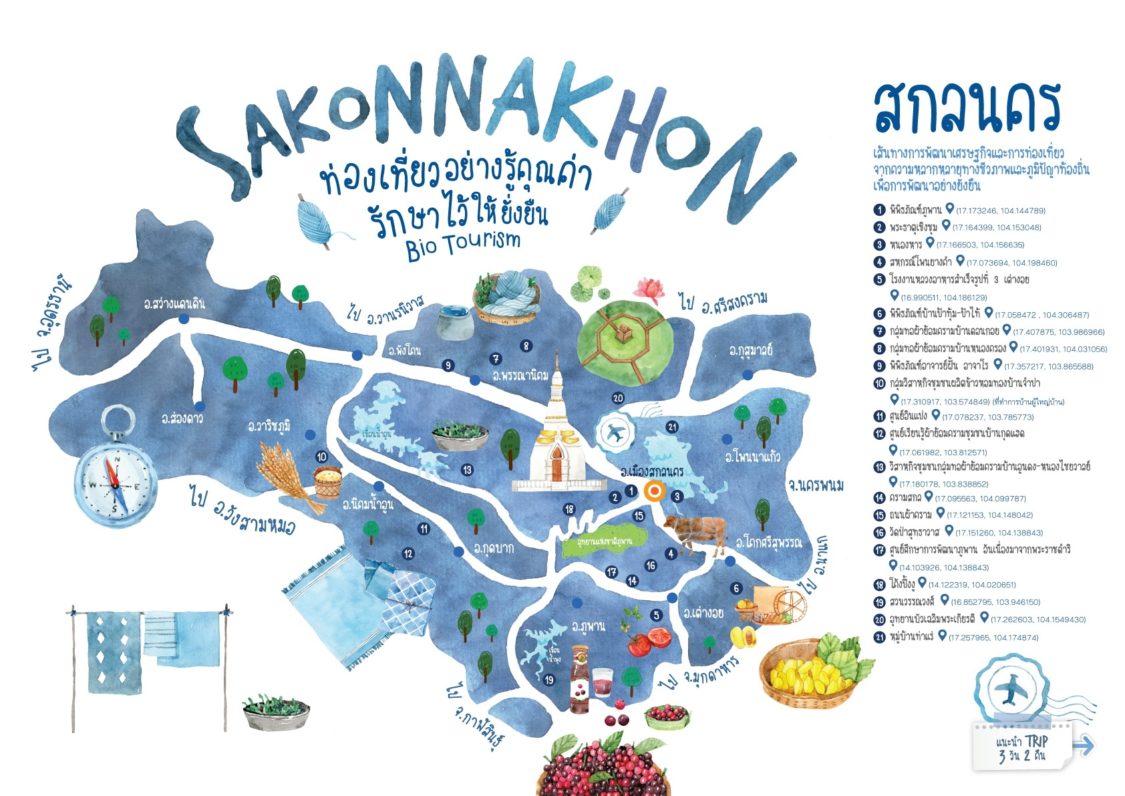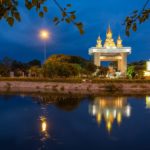
Sakon Nakhon Bio Tourism Culture Attractions

In 2017, Sakon Nakhon Rajabhat University organized an initiative which took tourists on a 3 day trip to Sakon Nakhon “Bio Tourism” cultural destinations that impart local wisdom and produce community made products. The promotional materials for the Sakon Nakhon tour were all produced in Thai, but we have now translated the important information into English for foreign tourists visiting Sakon Nakhon.

Sakon Nakhon Bio Tourism Destinations (as viewed on map)
1. Phu Phan Museum (พิพิธภัณฑ์ภูพาน) – Learn about the history and way of life of the Sakon Nakhon people
2. Wat Phra That Choeng Chum (พระธาตุเชิงชุม) – Visit an important Buddhist temple in the central part of the city.
3. Nong Han Lake (หนองหาร) – Take in the beautiful scenery of the largest fresh water lake in the Northeast of Thailand.
4. Pon Yang Kham Cooperative (สหกรณ์โพนยางคํา) – Enjoy the most delicious steaks in Thailand, made from specially bred local cattle.
5. The 3rd Royal Factory (โรงงานหลวงอาหารสําเร็จรูปที่3เต่างอย) – Taste flavorful tomatoes produced from Thailand’s first “Tomato Belt” farming area.
6. Baan Pa Toom-Pa Tai Museum (พิพิธภัณฑ์บ้านป้าตุ้ม-ป้าไก้) – Learn about traditional silk weaving culture in Sakon Nakhon.
7. Ban Don Koi Indigo Dye Weaving Group (กลุ่มทอผ้าย้อมครามบ้านดอนกอย) – Learn about the cultural traditions of Indigo dyeing and weaving, for which Sakon Nakhon is famous around the world.
8. Ban Nong Krong Indigo Dye Weaving Group (กลุ่มทอผ้าย้อมครามบ้านหนองครอง) – Browse additional Indigo dyed fabrics made by expert Sakon Nakhon crafts people. Located near Wat Ban Nong Khrong temple.
9. Ajarn Fun Acharo Museum (พิพิธภัณฑ์อาจารย์ฝั้นอาจา) – Learn about the famous Isaan monk Ajarn Fun, who helped establish the Buddhist forest tradition in Thailand.
10. Ban Champa Homthong Rice Production Community Enterprise Group (กลุ่มวิสาหกิจชุมชนผลิตข้าวหอมทองบ้านจำปา) – Purchase Sakon Nakhon’s famous rice from the farmers who were awarded as producing the best Jasmin rice in Thailand.
12. Inpang Community Center (ศูนย์อินแปง) – Learn about organic farming, sustainable living, and local crafts making by members of the Inpang forest network.
13. Ban Kut Haet Indigo Dyeing Center – Check out beautiful indigo dye silk products, including traditional costumes, skirts, clothes and shawls, made by the Ka Loeng ethnic community.
14. Ban Undong Indigo Weaving Group (กลุ่มทอผ้าครามบ้านอูนดง) – See the unique “turtle scale pattern” which the Undong weavers are famous for creating in their hand-dyed Indigo fabrics and clothing.
15. Kram Sakon (ตรามสกล) – Shop at this lovely store of high quality Indigo dyed products made by local Sakon Nakhon designers, and have a cup of coffee at their charming coffee shop.
16. Wat Pha Sutthawat (วัดป่าสุทธาวาส) – Visit the temple which is home to two Buddhist museums honoring the famous Northeastern Thai monks Achan Man Purithattha Thera and Luang Pu Louis Chanthasaro.
17. Phu Phan Royal Development Study Center (ศูนย์ศึกษาการพัฒนาภูพาน) – Learning about Royal initiatives related to the development of best practices in forestry, soil maintenance, water resources, agriculture, fishing, and livestock.
18. Ping Ngu (ได้งปิ้งงู) – Drive the famous winding “snake” road that connects Sakon Nakhon city to the Phu Phan mountain communities, and enjoy the nearby parks and waterfall.
19. Wan Wong Park & Winery (สวนวรรณวงศ์) – Discover delicious (not too sweet) local wine made from the Mak Mao berry, which has healthy, anti-toxin properties, as well as taste Mak Mao jams, juice, and cookies.
20. Tha Rae Village (หมู่บ้านท่าแร่) – Explore the largest Catholic community in Thailand, with its interesting European style architecture and the beautiful St. Anthony’s Cathedral.
Learn more about Sakon Nakhon’s popular tourist destinations, hidden treasures, and local culture by browsing our Sakon Nakhon Travel Guide.
- How to Greet a Monk in Thailand – Saying Hello - April 22, 2024
- The Hottest Place in Thailand – Record High Temperature - April 22, 2024
- The Thai Belief in Khwan: Spiritual Gift Giving in Thailand - April 21, 2024




